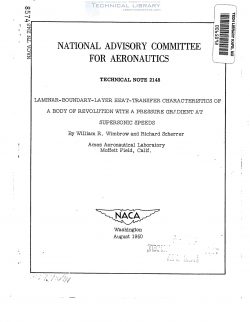naca-tn-2148
- Version
- 116 Downloads
- 1.08 MB File Size
- 1 File Count
- December 9, 2016 Create Date
- December 9, 2016 Last Updated
National Advisory Committee for Aeronautics, Technical Notes - Laminar Boundary Layer Heat Transfer Characteristics of a Body of Revolution with a Pressure Gradient at Supersonic Speeds

Local rates of heat transfer have been measured over the negative
pressure-gradient region of a pointed body of revolution with a fineness
ratio of 6:1, a vertex angle of 37°, and a contour generated by rotating
a segment of a parabola. Data have been obtained with a laminar boundary
layer at three Reynolds numbers at a Mach number of l.h9 and two Reynolds
numbers at a Mach number of 2.18. The results of this investigation indi-
cate that the heat—transfer characteristics of the parabolic body can be
predicted by employing the theoretical relationship between Nusselt num—
ber and Reynolds number for conical bodies.
The literature pertaining to convective heat transfer as it applies
to high—speed aerodynamics is restricted primarily to the consideration
of laminar flow'over flat plates. (See reference 1.) Along a flat plate
in supersonic flow the pressure is constant; consequently, the static
temperature at the outer edge of the boundary layer is also constant. In
contrast, the contour of the forward portion of a typical supersonic air—
craft body, often a segment of a circle or a parabola, gives rise to a
pressure field in which the pressure decreases with length along the body.
The static temperature is subject to a corresponding variation: The
differential equation defining laminar flow over such a surface can be
written readily but cannot be solved by ordinary means due to the variable
pressure and temperature terms. Approximate methods for determining the
heat—transfer characteristics of bodies of revolution with pressure gra—
dients are presanted in references 2 and 3. HOWever, the results obtained
are questionable due to the simplifying assumptions employed and both
methods are so tedious to apply that they are not considered practical
for design purposes.
In reference M3 bhngler presents relations whereby the characteris—
tics of a laminar boundary layer for an axially symmetric body of given
' contour and pressure distribution can be evaluated by calculating the
characteristics of a boundary layer on a twrhdimensional surface with an
equivalent pressure distribution and then correcting for the effect of
the varying circumference of the axially syumetric body. Since two—
dimensional solutions are restricted by mathematical limitations to the
constant pressure case, the resulting solutions for axially symmetric
flow are also limited to the constant pressure case and hence to conical
bodies. From.Mangler's nethod, however, one can deduce that the boundary
layer, and hence the rate of heat transfer; for a body of revolution with
a negative pressure gradient is affected by two factors not affecting the
boundary layer on a flat plate. One factor is the variation of the cir—
cumference of the body of revolution with length and the other is the
effect of the pressure gradient.
| File | Action |
|---|---|
| naca-tn-2148 Laminar Boundary Layer Heat Transfer Characteristics of a Body of Revolution with a Pressure Gradient at Supersonic Spe.pdf | Download |
Comment On This Post